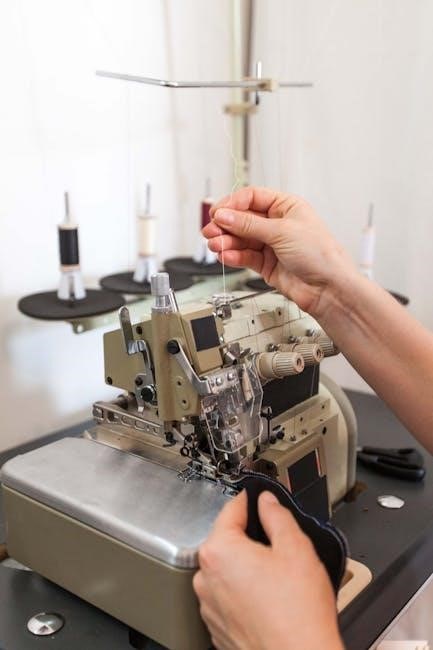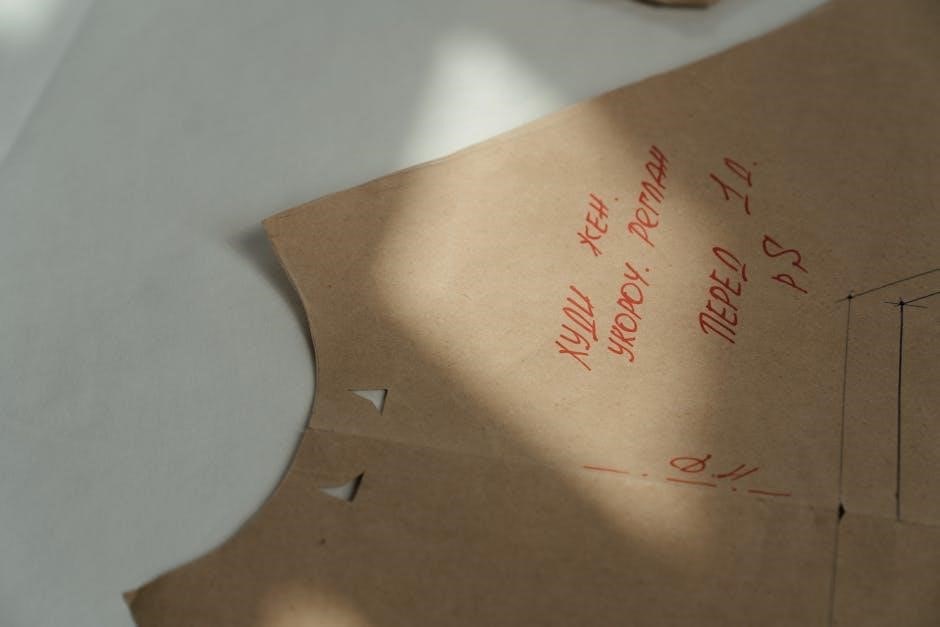Welcome to the Singer Sew Mate 5400 instruction manual! This guide helps you master your sewing machine’s features, from setup to advanced techniques. Read carefully for optimal performance.
Overview of the Singer Sew Mate 5400 Sewing Machine
The Singer Sew Mate 5400 is a versatile sewing machine designed for both beginners and experienced sewists. It features an automatic needle threader, 1-step buttonhole, and adjustable stitch length, offering convenience and precision. With multiple stitch options, it handles various fabrics and projects effortlessly. The machine is user-friendly, making it ideal for sewing, quilting, and crafting. Its durable construction ensures long-term performance, while the included manual provides clear guidance for getting started and troubleshooting common issues.
Importance of Reading the Instruction Manual
Reading the Singer Sew Mate 5400 instruction manual is crucial for understanding its features, proper setup, and maintenance. It ensures safety, helps troubleshoot issues, and maximizes performance. The manual provides step-by-step guides for using advanced features like the automatic needle threader and 1-step buttonhole, while also offering maintenance tips to extend the machine’s life. By following the manual, users can avoid common errors, optimize sewing results, and make the most of their investment in this versatile sewing machine.

Key Features and Benefits of the Singer Sew Mate 5400
The Singer Sew Mate 5400 offers an automatic needle threader, 1-step buttonhole, adjustable stitch length, and multiple stitch options, ensuring versatility and ease for various sewing projects.
Automatic Needle Threader
The Singer Sew Mate 5400 features an automatic needle threader, simplifying the threading process. This convenient feature allows you to thread the needle with minimal effort. Simply follow the guide, and the machine does the rest. It’s designed to save time and reduce eye strain, making it ideal for sewers of all skill levels. This feature is especially helpful for those who find manual threading challenging. It ensures accurate and quick needle threading every time.
1-Step Buttonhole Feature
The Singer Sew Mate 5400’s 1-Step Buttonhole Feature creates professional-quality buttonholes effortlessly. This innovative function guides you through a single-step process, ensuring consistent results. Perfect for clothing, home decor, and crafts, it eliminates the need for manual adjustments. Simply select the buttonhole option, and the machine automatically sews a precise hole with matching stitching. This feature saves time and enhances your sewing projects with a polished finish, making it ideal for both beginners and experienced sewers alike.
Adjustable Stitch Length and Width
The Singer Sew Mate 5400 offers adjustable stitch length and width, providing versatility for various fabrics and projects. Easily customize your stitches to suit your needs, whether it’s delicate lingerie or heavy-duty upholstery. The machine’s intuitive controls allow you to fine-tune settings, ensuring optimal results. This feature enhances creativity and precision, making it ideal for both basic and advanced sewing tasks. Adjustments are simple, enabling you to achieve professional-quality stitching with minimal effort.
Multiple Stitch Options for Versatility
The Singer Sew Mate 5400 offers a wide range of stitch options, ensuring versatility for various sewing projects. From basic straight stitches to intricate decorative patterns, the machine caters to different fabric types and creative needs. Choose from zigzag, blind hem, and stretch stitches for adaptable sewing solutions. The machine’s intuitive design allows easy selection of stitches, optimizing your workflow. With multiple stitch options, you can tackle everything from delicate fabrics to heavy-duty materials with precision and ease, making it perfect for both beginners and experienced sewists.

Unpacking and Package Contents
Ensure your Singer Sew Mate 5400 package includes the machine, power cord, needles, bobbins, and additional accessories. Verify all components are present before proceeding.
Checking the Box for All Included Accessories
Before proceeding, ensure your Singer Sew Mate 5400 package contains all listed components. This includes the sewing machine, power cord, needles, bobbins, and additional accessories. Carefully unpack each item and cross-reference them with the packaging list provided in the manual. If any item is missing or damaged, contact Singer customer support immediately. Properly verifying the contents ensures you have everything needed for setup and operation. This step is crucial for a smooth sewing experience.
Understanding the Machine Components
Familiarize yourself with the Singer Sew Mate 5400’s components to ensure proper operation. Key parts include the needle, bobbin, stitch selector, and tension dials. The automatic needle threader simplifies threading, while the 1-step buttonhole feature offers convenience. The machine also includes multiple stitch options for versatility. Locate the power switch, foot pedal, and accessory compartment. Understanding each part’s function will help you navigate settings and troubleshooting. Refer to the manual’s diagrams for visual identification and guidance on component locations and purposes.

Setting Up the Singer Sew Mate 5400
Setting up your Singer Sew Mate 5400 involves unpacking, placing it on a stable surface, and powering it up. Ensure all components are included and functional.
Unpacking and Preparing the Machine
Begin by carefully unpacking the Singer Sew Mate 5400 and all accessories. Ensure the machine is free from packaging materials. Locate the power cord, foot pedal, and additional attachments. Before first use, inspect the machine for any damage or debris. Gently wipe down the exterior with a soft cloth to remove any dust or residue from shipping. This preparation ensures smooth operation and prevents initial setup issues.
Placing the Machine on a Stable Work Surface
Position the Singer Sew Mate 5400 on a sturdy, flat work surface, ensuring stability during operation. Avoid uneven or wobbly tables to prevent vibrations and maintain consistent stitching. Place the machine away from direct sunlight and moisture to protect its electrical components. Ensure the surface is clean and free from clutter, allowing easy access to the machine’s controls and compartments. Proper placement enhances safety, reduces noise, and promotes smooth sewing experiences. Always ensure good lighting in your workspace for visibility.
Initial Power-Up and Settings
Before first use, ensure the Singer Sew Mate 5400 is properly plugged into a grounded power outlet. Turn on the machine and check that all lights and controls function correctly. Set the stitch length and width to default settings for initial use. Insert a new needle and thread the machine as instructed. Test the machine on scrap fabric to ensure proper stitching. Adjust tension settings if necessary for optimal performance. Refer to the manual for specific settings tailored to your fabric type and project needs. Always start with a test stitch to verify settings.

Operating the Singer Sew Mate 5400
Mastering the Singer Sew Mate 5400 involves selecting the right stitches, adjusting settings, and using advanced features like the automatic needle threader for efficient sewing sessions.
Selecting the Right Stitch for Your Project
The Singer Sew Mate 5400 offers multiple stitch options to suit various sewing tasks. Choose from straight stitch, zigzag, decorative, and stretch stitches for different fabrics and projects. The machine automatically adjusts stitch length and width based on your selection, ensuring optimal results. For example, use the straight stitch for basic sewing, zigzag for elastic fabrics, and decorative stitches for embellishments. Always refer to the stitch chart in the manual to match the right stitch with your fabric type for professional-looking outcomes. Experiment with different settings to achieve the desired effect.
Using the Automatic Needle Threader
To use the automatic needle threader on the Singer Sew Mate 5400, start by turning off and unplugging the machine for safety. Locate the needle threader lever, typically found near the needle bar. Pull the lever down to engage the threader. Gently guide the thread through the threader’s hook, ensuring it seats properly. Release the lever to allow the thread to pass through the needle. This convenient feature saves time and reduces eye strain, making threading quick and effortless for all your sewing projects.
Adjusting the Stitch Length and Tension
Adjust the stitch length and tension on the Singer Sew Mate 5400 to achieve precise results. Use the stitch length dial to set the desired length, typically between 0-4mm. For tension, locate the bobbin case and adjust the small screw to balance the thread flow. Ensure the needle thread is taut but not overly tight. Test on scrap fabric to confirm even stitching. Proper adjustment ensures smooth sewing and prevents fabric puckering or loose threads, enhancing overall project quality and durability.
Controlling the Sewing Speed

Control the sewing speed on your Singer Sew Mate 5400 with the adjustable speed slider. Set it to slow for intricate patterns or heavy fabrics and increase for straight stitching. The machine offers consistent speed control, allowing you to manage your sewing pace effectively. This feature is particularly useful for beginners or when working on delicate materials. Adjusting the speed ensures accuracy and prevents mistakes, making your sewing experience more enjoyable and efficient, regardless of the project’s complexity or fabric type used.

Maintenance and Care
Regular maintenance ensures your Singer Sew Mate 5400 runs smoothly. Clean the machine, oil moving parts, and replace the needle as needed for optimal performance.

Cleaning the Machine Regularly
Regular cleaning is essential for maintaining your Singer Sew Mate 5400. Turn off and unplug the machine, then remove the needle plate and bobbin case. Use a soft brush to sweep away lint and debris from the interior. Dampen a cloth with water, gently wipe down exterior surfaces, and avoid harsh chemicals. Proper cleaning ensures smooth operation, prevents dust buildup, and extends the machine’s lifespan. Perform this routine after every project for optimal performance.
Oiling the Machine for Smooth Operation
Oiling your Singer Sew Mate 5400 ensures smooth operation and prevents mechanical friction. Turn off and unplug the machine, then remove the needle plate and bobbin case. Apply one drop of sewing machine oil to the recommended areas, as indicated in the manual. Allow the oil to settle before use. Regular lubrication maintains performance and extends the machine’s lifespan. Always use high-quality sewing machine oil to avoid damage and keep your Sew Mate 5400 running effortlessly.
Regularly Checking and Replacing the Needle
Regularly inspect the needle for signs of damage, such as bending, dullness, or rust. A damaged needle can cause poor stitching, fabric tears, or machine jams. Replace the needle every 1-2 months or when you notice issues. To replace, turn off the machine, lift the needle clamp screw, remove the old needle, and insert the new one, ensuring it’s securely fastened. Proper needle maintenance ensures smooth sewing and prevents thread breakage, while also maintaining consistent stitch quality for professional results.

Troubleshooting Common Issues
Troubleshooting common issues with your Singer Sew Mate 5400 ensures optimal performance. Identify problems like thread tension, fabric jams, or buttonhole malfunctions and resolve them promptly for smooth sewing.
Resolving Thread Tension Problems
Thread tension issues can disrupt your sewing. Check the bobbin and top thread for proper alignment and ensure they are not tangled. Adjust the tension dials gently, as over-tightening can cause fabric puckering. If the issue persists, clean the tension discs and rethread the machine. Always refer to the Singer Sew Mate 5400 manual for specific tension settings to maintain even stitching and prevent fabric damage during your projects.
Fixing Jammed Fabric or Thread
If fabric or thread jams, stop sewing immediately. Turn off the machine and unplug it for safety. Gently remove any tangled fabric or thread. Check the needle plate and bobbin area for debris. Use scissors to carefully cut any knotted thread. Reassemble the machine, ensuring all parts are securely in place. Test the machine with a scrap fabric to ensure smooth operation. Regular cleaning and proper threading can help prevent future jams and maintain your sewing experience. Always follow the manual’s guidance for best results.
Addressing Issues with the Buttonhole Feature
If the buttonhole feature malfunctions, ensure the buttonhole lever is properly activated. Check that fabric is aligned correctly and the buttonhole size matches your button. Restart the cycle and verify thread tension. If issues persist, clean the machine’s buttonhole area to remove debris. Ensure the needle is in good condition and correctly inserted. Refer to the manual for specific buttonhole settings and troubleshooting steps to resolve the issue effectively and maintain optimal performance of your Singer Sew Mate 5400 sewing machine.

Advanced Features and Techniques
Explore advanced sewing techniques with the Singer Sew Mate 5400, including custom buttonholes, heavy-duty fabric sewing, and customizable stitch settings for enhanced creativity and precision in your projects.
Creating Custom Buttonholes
The Singer Sew Mate 5400 allows you to create custom buttonholes with ease. Using the 1-Step Buttonhole feature, you can achieve professional results without manual adjustments. Simply select the buttonhole stitch, place your fabric, and let the machine guide you through the process. The machine automatically adjusts stitch length and width for optimal results. This feature is perfect for shirts, dresses, and other garments requiring precise buttonholes. With the Sew Mate 5400, you can customize buttonhole size and shape to match your project needs, ensuring a polished finish every time.
Using the Machine for Heavy-Duty Fabrics
The Singer Sew Mate 5400 can handle heavy-duty fabrics like denim or canvas with ease. For best results, use the heavy-duty needle and adjust the stitch length and tension settings. Select the straight stitch or reinforced stitch option for added strength. Use a walking foot or Teflon foot for smooth fabric movement. Maintain a steady pace to prevent fabric jams. This machine’s robust design ensures professional-grade stitching on thick materials, making it ideal for upholstery, bags, or heavy-duty sewing projects.
Customizing Stitch Settings for Special Projects
Customizing stitch settings on the Singer Sew Mate 5400 allows you to tailor your sewing to specific projects. Adjust the stitch length and width to suit delicate fabrics or heavy materials. For decorative stitching, explore the machine’s decorative stitch options. Use the adjustable tension to ensure even stitching on unique fabrics like silk or fleece. Experiment with custom combinations to achieve the desired texture and appearance for your special projects, ensuring professional-quality results every time.
Mastering the Singer Sew Mate 5400 enhances your sewing experience. Regular maintenance ensures optimal performance. Explore its features to create stunning, professional-quality projects effortlessly.
Best Practices for Long-Term Machine Performance
- Regularly clean the machine to prevent dust buildup and ensure smooth operation.
- Lubricate moving parts periodically to maintain efficiency and prevent wear.
- Always use the correct needle type and size for your fabric to avoid damage.
- Adjust thread tension properly to prevent issues and achieve consistent stitches.
- Store the machine in a dry, cool place and cover it when not in use.
- Follow the manual’s guidelines for maintenance and troubleshooting.
Recommended Accessories for Enhanced Sewing
- Invest in a variety of sewing needles (sharp, universal, heavy-duty) for different fabric types.
- Use presser feet like the zipper or walking foot for specialized tasks.
- Keep extra bobbins and bobbin cases for quick thread changes.
- Utilize a sewing machine oil kit to maintain smooth operation.
- Consider a sewing table or extension table for better fabric control.
- Store supplies in a sewing kit or organizer for easy access.